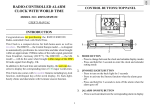Download AMCC Security Look-aside Driver Security Look
Transcript
Revision 1.00 - February 28, 2008
Preliminary User’s Manual
AMCC Security Look-aside Driver
Security Look-aside Driver (SLAD)
for
AMCC Security Co-Processor, v2.2
User’s Manual
AMCC
1
Revision 1.00 - February 28, 2008
AMCC Security Look-aside Driver
Preliminary User’s Manual
Copyright and Disclaimer
Applied Micro Circuits Corporation
215 Moffett Park Drive, Sunnyvale, CA 94089
Phone: (408) 542-8600 — Fax: (408) 542-8601
http://www.amcc.com
AMCC reserves the right to make changes to its products, its datasheets, or related documentation, without notice and warrants its
products solely pursuant to its terms and conditions of sale, only to substantially comply with the latest available datasheet. Please
consult AMCC’s Term and Conditions of Sale for its warranties and other terms, conditions and limitations. AMCC may discontinue
any semiconductor product or service without notice, and advises its customers to obtain the latest version of relevant information
to verify, before placing orders, that the information is current. AMCC does not assume any liability arising out of the application or
use of any product or circuit described herein, neither does it convey any license under its patent rights nor the rights of others.
AMCC reserves the right to ship devices of higher grade in place of those of lower grade.
AMCC SEMICONDUCTOR PRODUCTS ARE NOT DESIGNED, INTENDED, AUTHORIZED, OR WARRANTED TO BE SUITABLE FOR USE IN LIFE-SUPPORT APPLICATIONS, DEVICES OR SYSTEMS OR OTHER CRITICAL APPLICATIONS.
AMCC is a registered Trademark of Applied Micro Circuits Corporation. Copyright © 2007 Applied Micro Circuits Corporation.
PowerPC and PowerPC logo are registered trademarks of IBM Corporation. All other trademarks are the property of their
respective holders.
All Rights Reserved.
2
AMCC
Revision 1.00 - February 28, 2008
Preliminary User’s Manual
AMCC Security Look-aside Driver
Contents
1. Introduction ............................................................................................................................... 9
1.1 Acronyms . . . . . . . . . . . . . . . . . . . . . . . . . . . . . . . . . . . . . . . . . . . . . . . . . . . . . . . . . . . . . . . . . . . . . 9
1.2 Overview . . . . . . . . . . . . . . . . . . . . . . . . . . . . . . . . . . . . . . . . . . . . . . . . . . . . . . . . . . . . . . . . . . . . . 10
1.2.1 Initialization and Configuration Overview . . . . . . . . . . . . . . . . . . . . . . . . . . . . . . . . . . . . . . . 12
1.2.2 Operation after Initialization . . . . . . . . . . . . . . . . . . . . . . . . . . . . . . . . . . . . . . . . . . . . . . . . . 12
1.3 General Notes . . . . . . . . . . . . . . . . . . . . . . . . . . . . . . . . . . . . . . . . . . . . . . . . . . . . . . . . . . . . . . . . 12
1.3.1 Device Numbers . . . . . . . . . . . . . . . . . . . . . . . . . . . . . . . . . . . . . . . . . . . . . . . . . . . . . . . . . . 12
1.3.2 Virtual Memory and Physical Memory . . . . . . . . . . . . . . . . . . . . . . . . . . . . . . . . . . . . . . . . . . 12
1.3.3 CGX Command Parsing . . . . . . . . . . . . . . . . . . . . . . . . . . . . . . . . . . . . . . . . . . . . . . . . . . . . 12
1.3.4 RSA-CRT Modular Exponentiation . . . . . . . . . . . . . . . . . . . . . . . . . . . . . . . . . . . . . . . . . . . . 13
1.3.5 Target Mode vs. Autonomous Ring Mode . . . . . . . . . . . . . . . . . . . . . . . . . . . . . . . . . . . . . . . 13
2. SLAD API Function Summary ............................................................................................... 14
2.1 SLAD Function Details . . . . . . . . . . . . . . . . . . . . . . . . . . . . . . . . . . . . . . . . . . . . . . . . . . . . . . . . . .
2.1.1 slad_driver_version . . . . . . . . . . . . . . . . . . . . . . . . . . . . . . . . . . . . . . . . . . . . . . . . . . . . . . . .
2.1.2 slad_device_info . . . . . . . . . . . . . . . . . . . . . . . . . . . . . . . . . . . . . . . . . . . . . . . . . . . . . . . . . .
2.1.3 slad_setup_pe_initblk . . . . . . . . . . . . . . . . . . . . . . . . . . . . . . . . . . . . . . . . . . . . . . . . . . . . . .
2.1.4 slad_pe_init . . . . . . . . . . . . . . . . . . . . . . . . . . . . . . . . . . . . . . . . . . . . . . . . . . . . . . . . . . . . . .
2.1.5 slad_pka_init . . . . . . . . . . . . . . . . . . . . . . . . . . . . . . . . . . . . . . . . . . . . . . . . . . . . . . . . . . . . .
2.1.6 slad_rng_init . . . . . . . . . . . . . . . . . . . . . . . . . . . . . . . . . . . . . . . . . . . . . . . . . . . . . . . . . . . . .
2.1.7 slad_pe_uninit . . . . . . . . . . . . . . . . . . . . . . . . . . . . . . . . . . . . . . . . . . . . . . . . . . . . . . . . . . . .
2.1.8 slad_pka_uninit . . . . . . . . . . . . . . . . . . . . . . . . . . . . . . . . . . . . . . . . . . . . . . . . . . . . . . . . . . .
2.1.9 slad_rng_uninit . . . . . . . . . . . . . . . . . . . . . . . . . . . . . . . . . . . . . . . . . . . . . . . . . . . . . . . . . . .
2.1.10 slad_register_sa . . . . . . . . . . . . . . . . . . . . . . . . . . . . . . . . . . . . . . . . . . . . . . . . . . . . . . . . .
2.1.11 slad_register_srec . . . . . . . . . . . . . . . . . . . . . . . . . . . . . . . . . . . . . . . . . . . . . . . . . . . . . . . .
2.1.12 slad_unregister_sa . . . . . . . . . . . . . . . . . . . . . . . . . . . . . . . . . . . . . . . . . . . . . . . . . . . . . . .
2.1.13 slad_pkt_put . . . . . . . . . . . . . . . . . . . . . . . . . . . . . . . . . . . . . . . . . . . . . . . . . . . . . . . . . . . .
2.1.14 slad_pkt_get . . . . . . . . . . . . . . . . . . . . . . . . . . . . . . . . . . . . . . . . . . . . . . . . . . . . . . . . . . . .
2.1.15 slad_pkt_sync . . . . . . . . . . . . . . . . . . . . . . . . . . . . . . . . . . . . . . . . . . . . . . . . . . . . . . . . . . .
2.1.16 slad_pkt_ready . . . . . . . . . . . . . . . . . . . . . . . . . . . . . . . . . . . . . . . . . . . . . . . . . . . . . . . . . .
2.1.17 slad_bus_read . . . . . . . . . . . . . . . . . . . . . . . . . . . . . . . . . . . . . . . . . . . . . . . . . . . . . . . . . . .
2.1.18 slad_bus_write . . . . . . . . . . . . . . . . . . . . . . . . . . . . . . . . . . . . . . . . . . . . . . . . . . . . . . . . . .
2.1.19 slad_allocate_buffer . . . . . . . . . . . . . . . . . . . . . . . . . . . . . . . . . . . . . . . . . . . . . . . . . . . . . .
2.1.20 slad_free_buffer . . . . . . . . . . . . . . . . . . . . . . . . . . . . . . . . . . . . . . . . . . . . . . . . . . . . . . . . .
2.1.21 slad_buffer_copy_in . . . . . . . . . . . . . . . . . . . . . . . . . . . . . . . . . . . . . . . . . . . . . . . . . . . . . .
2.1.22 slad_buffer_copy_out . . . . . . . . . . . . . . . . . . . . . . . . . . . . . . . . . . . . . . . . . . . . . . . . . . . . .
2.1.23 slad_map_addr_range . . . . . . . . . . . . . . . . . . . . . . . . . . . . . . . . . . . . . . . . . . . . . . . . . . . .
2.1.24 slad_unmap_addr_range . . . . . . . . . . . . . . . . . . . . . . . . . . . . . . . . . . . . . . . . . . . . . . . . . .
2.1.25 slad_get_random . . . . . . . . . . . . . . . . . . . . . . . . . . . . . . . . . . . . . . . . . . . . . . . . . . . . . . . .
2.1.26 slad_expmod . . . . . . . . . . . . . . . . . . . . . . . . . . . . . . . . . . . . . . . . . . . . . . . . . . . . . . . . . . . .
2.1.27 slad_expcrtmod . . . . . . . . . . . . . . . . . . . . . . . . . . . . . . . . . . . . . . . . . . . . . . . . . . . . . . . . . .
2.2 Function Return Codes . . . . . . . . . . . . . . . . . . . . . . . . . . . . . . . . . . . . . . . . . . . . . . . . . . . . . . . . . .
15
15
15
15
16
16
16
16
17
17
17
18
18
19
19
20
20
20
21
21
21
22
22
22
23
23
23
24
25
3. Data Structures ....................................................................................................................... 26
3.1 SLAD_DEVICEINFO . . . . . . . . . . . . . . . . . . . . . . . . . . . . . . . . . . . . . . . . . . . . . . . . . . . . . . . . . . .
3.2 PE_INIT_BLOCK . . . . . . . . . . . . . . . . . . . . . . . . . . . . . . . . . . . . . . . . . . . . . . . . . . . . . . . . . . . . . .
3.3 PKA_INIT_BLOCK . . . . . . . . . . . . . . . . . . . . . . . . . . . . . . . . . . . . . . . . . . . . . . . . . . . . . . . . . . . . .
3.4 RNG_INIT_BLOCK . . . . . . . . . . . . . . . . . . . . . . . . . . . . . . . . . . . . . . . . . . . . . . . . . . . . . . . . . . . . .
3.5 SLAD_NOTIFY . . . . . . . . . . . . . . . . . . . . . . . . . . . . . . . . . . . . . . . . . . . . . . . . . . . . . . . . . . . . . . . .
3.6 SLAD_PKT . . . . . . . . . . . . . . . . . . . . . . . . . . . . . . . . . . . . . . . . . . . . . . . . . . . . . . . . . . . . . . . . . . .
3.7 Security Association (SA) Record Format . . . . . . . . . . . . . . . . . . . . . . . . . . . . . . . . . . . . . . . . . . .
3.8 State Record . . . . . . . . . . . . . . . . . . . . . . . . . . . . . . . . . . . . . . . . . . . . . . . . . . . . . . . . . . . . . . . . . .
3.9 RANDOM_PARAM_BLK . . . . . . . . . . . . . . . . . . . . . . . . . . . . . . . . . . . . . . . . . . . . . . . . . . . . . . . .
AMCC
26
26
30
31
31
32
34
36
37
3
Revision 1.00 - February 28, 2008
AMCC Security Look-aside Driver
Preliminary User’s Manual
3.10 EXPMOD_PARAM_BLK . . . . . . . . . . . . . . . . . . . . . . . . . . . . . . . . . . . . . . . . . . . . . . . . . . . . . . . 38
3.11 EXPCRT_PARAM_BLK . . . . . . . . . . . . . . . . . . . . . . . . . . . . . . . . . . . . . . . . . . . . . . . . . . . . . . . . 39
Index ............................................................................................................................................ 57
Revision Log ............................................................................................................................... 55
4
AMCC
Revision 1.00 - February 28, 2008
Preliminary User’s Manual
Figure 1-1.
AMCC
AMCC Security Look-aside Driver
SLAD Communications ..........................................................................................................11
5
Revision 1.00 - February 28, 2008
AMCC Security Look-aside Driver
6
Preliminary User’s Manual
AMCC
Revision 1.00 - February 28, 2008
Preliminay User’s Manual
AMCC Security Look-aside Driver
Table 1-1.
List of Acronyms .......................................................................................................................9
Table 2-1.
List of SLAD API Functions ....................................................................................................14
Table 2-2.
Function Return Codes ...........................................................................................................25
Table 3-1.
PE_INIT_BLOCK Element Values ..........................................................................................28
Table 3-2.
SLAD Notify ............................................................................................................................31
Table 3-3.
SLAD PKT ..............................................................................................................................32
Table 3-4.
State Record ...........................................................................................................................36
Table 3-5.
Random Param Blk ................................................................................................................37
Table 3-6.
EXPMOD Param Blk ..............................................................................................................38
Table 3-7.
EXPCRT Param Blk ...............................................................................................................39
Table 3-8.
SLAD_BUSID_xxx Definitions ................................................................................................43
AMCC
7
Revision 1.00 - February 28, 2008
AMCC Security Look-aside Driver
8
Preliminary User’s Manual
AMCC
Revision 1.00 - February 28, 2008
Preliminary User’s Manual
AMCC Security Look-aside Driver
Abstract
This document is derived from the original, Security Look-aside Accelerator Driver (SLAD) User Manual, 1.7,
Date: 11 Jan, 2008.
Any errors noted here would be translation errors from the original.
Any additions will be duly marked as such and do not reflect back to the original documentation.
1. Introduction
The Security Look-aside Driver (SLAD) provides a driver that is used by user-mode and kernel-mode applications
to communicate with the security engine used in applicable AMCC processor products. This driver implements an
Application Programming Interface (API) for communication between applications and the security engine. This
manual is primarily intended for a software developers.
For general information about AMCC processors products, please visit the AMCC Web site at:
http://www.amcc.com/Embedded/
1.1 Acronyms
Table 1-1 provides a list of all acronyms used in this manual.
Table 1-1. List of Acronyms
IP
Internet Protocol
AH
IPSec Authentication Header
IPcomp
IP Compression Protocol
API
Application Programming Interface
IPSec
IP Security Protocol
BM
Byte Memory
IV
Initialization Vector
CBC
Cipher Block Chaining Mode
KCR
Key Cache Register
CC
Crypto Context
KEK
Key Encryption Key
CDR
CGX Descriptor Ring
KRAM
Kernel RAM
CFB
Cipher Feedback Mode
LSV
Local Storage Variable (KEK)
CGX
Cryptographic Extensions Library
MD5
Message Digest 5
CPI
Compression Parameters Index
OFB
Output Feedback Mode
CRT
Chinese Remainder Theorem
PCDB
Program Control Data Bits
DEK
Data Encryption Key
PDR
Packet Descriptor Ring
DES
Data Encryption Standard
PF
Programmable Flags
DH
Diffie-Hellman
PKA
Public Key Acceleration
DKEK
Hash/Encrypt Data Key Protection KEK
PKCP
Public Key Co-Processor
DM
Data Memory
PM
Program Memory
DSA
Digital Signature Algorithm
RAM
Random Access Memory
AMCC
9
Revision 1.00 - February 28, 2008
Preliminary User’s Manual
AMCC Security Look-aside Driver
Table 1-1. List of Acronyms
DSP
Digital Signal Processor
RDR
Result Descriptor Ring
ECB
Electronic Codebook Mode
ROM
Read Only Memory
EMI
External Memory Interface
RNG
Random Number Generator
ESP
IPSec Security Encapsulating Payload
RSA
Rivest, Shamir, Adelman (public key algorithm)
GKEK
Generator KEK
SA
Security Association
HMAC
Hash Message Authentication Code
SHA-1
Secure Hash algorithm, Version 1
IKE
Internet Key Exchange
SPI
Security Parameters Index
1.2 Overview
The Security Look-aside Driver (SLAD) is a very flexible driver that facilitates communication between security
applications and the security engine subsystem. It provides services to both kernel-mode and user-mode applications.
AMCC SLAD uses a pair of descriptor rings for communication with the host system. These rings are designated
as the Packet Descriptor Ring (PDR) and the CGX Descriptor Ring (CDR).
The driver is responsible for setting up and managing these rings on behalf of the host application. For details
about the behavior and control of these rings, please refer to the PPC405/PPC460 User Manual. The driver is also
responsible for booting, initializing and configuring the hardware device subsystem.
The driver provides the following primary functions:
• Initialization, de-initialization and general management of the hardware subsystem
• Functions to put commands on, and get results back from the CGX Descriptor Ring (CDR)
• Functions to put commands on, and get results back from the Packet Descriptor Ring (PDR)
• Functions to read and write directly to the security co-processor
• Buffer management functions such as allocate, copy in and copy out
Figure 1-1 provides an overview of the driver. To minimize waiting for applications, SLAD maintains two rings-PDR
and CDR. Generally applications put commands in PDR while only the CGX library uses the CDR. The SLAD interacts with the security-device to execute the required commands. The SLAD maintains a pool of memory to store
the data received from applications and the security-device. Since the security-device may read and write data
directly to the memory through DMA, the memory is non-paged and locked.
10
AMCC
Revision 1.00 - February 28, 2008
Preliminary User’s Manual
AMCC Security Look-aside Driver
Figure 1-1. SLAD Communications
IPSec IKE
Application
IPSec Packet
Application
Other Security
Applications
Security Look-aside Driver
Packet
Descriptor Ring
(PDR)
CGX
Descriptor Ring
(CDR)
Locked Down
Non Paged
Memory Pool
Processor Local Bus
AMCC
Security
Co-Processor
AMCC
11
Revision 1.00 - February 28, 2008
AMCC Security Look-aside Driver
Preliminary User’s Manual
1.2.1 Initialization and Configuration Overview
The initialization and configuration functions of the SLAD prepare the security co-processor for operation. This may
include the following steps:
1. Bootloading any operating code into the security co-processor device.
2. Passing values from the PE_INIT_BLOCK structure into the hardware device. The PE_INIT_BLOCK is used to
define the configuration options for the device as well as the settings for various registers within the device.
1.2.2 Operation after Initialization
Once the hardware device is booted and initialized, the driver manages the descriptor rings and thus the submission of commands to the co-processor. Its operation is asynchronous to the host processor, as descriptor rings are
used for inter-process communications.
1.3 General Notes
This section provides miscellaneous information about the SLAD.
1.3.1 Device Numbers
The SLAD supports more than one security co-processor at a time. The current implementation only assumes a
single device, numbered zero (0).
1.3.2 Virtual Memory and Physical Memory
When a security co-processor device is accessing data stored in system memory, for example, across a PCI bus, it
is always referencing physical memory locations. Linux supports “virtual memory” and implements “paged
memory,” which allows different banks of memory to be switched in for access. Both virtual memory and paged
memory pose a problem, because the physical addressing used by the security co-processor cannot understand
virtual or paged addresses.
To avoid this problem, data must be placed in contiguous, non-paged, non-virtual memory (locked). Most kernelmode applications only operate out of non-paged non-virtual memory, so there is no issue in the kernel space.
However, data originating in the user space will generally have to be copied by the driver into non-paged memory.
The driver copies the user mode application data into driver allocated/managed bounce buffers.
1.3.3 CGX Command Parsing
In systems with virtual or paged memory, the security co-processor may have to fetch its CGX arguments as a bus
master, and it will, of course, use physical addresses. As with packet operations, the arguments will have to be
stored in locked, non-paged memory. The driver takes care of this by parsing each CGX command, isolating the
pointer type arguments, and then copying the argument data from the virtual location to a physical, locked memory
area.
12
AMCC
Revision 1.00 - February 28, 2008
Preliminary User’s Manual
AMCC Security Look-aside Driver
1.3.4 RSA-CRT Modular Exponentiation
The formula for RSA-CRT modular exponentiation is as follows (definitions of the variables used are provided after
the formula):
/*** Garner Recombination ***/
if(mp >= mq)
tmp1 = mp – mq
else (where QINV=MODQ-1 mod MODP)
tmp1 = mq – mp
tmp1 = MODP – tmp1
tmp2 = (QINV * tmp1) mod MODP
RESULT = (tmp2 * MODQ) + mq
where:
cp
INPUT mod MODP
cq
INPUT mod MODQ
mp
cpDP mod MODP
mq
cqDQ mod MODQ
1.3.5 Target Mode vs. Autonomous Ring Mode
All the APIs shall use Autonomous ring mode. Target mode is implemented only for debugging purposes and
should not be used in any production environment.
AMCC
13
Revision 1.00 - February 28, 2008
Preliminary User’s Manual
AMCC Security Look-aside Driver
2. SLAD API Function Summary
The following table provides a summary of the SLAD API functions (the platform-specific sections also be examined in order to determine if there have been any additions or subtractions to this list):
Table 2-1. List of SLAD API Functions
Function Name
Notes
slad_driver_version
Returns the slad version number
slad_device_info
Returns the SLAD_DEVICEINFO structure for a specified device
slad_setup_pe_initblk
Fills up the default values in the PE_INIT_BLOCK structure
slad_pe_init
Initializes the hardware co-processor using a supplied PE_INIT_BLOCK structure
slad_pe_uninit
Un-initializes the hardware co-processor and de-allocates buffer memory
slad_pka_init
Initializes the security hardware PKA using a supplied PKA_INIT_BLOCK structure
slad_pka_uninit
Un-initializes the security hardware PKA
slad_rng_init
Initializes the security hardware random number generator using a supplied RNG_INIT_BLOCK structure
slad_rng_uninit
Un-initialize the security hardware random number generator
slad_register_sa
Register SA with the driver. After registration, SA can be used in slad_pkt_put/slad_cgx_put functions
slad_register_srec
Register Srec so that the driver may associate it with its corresponding SA
slad_unregister_sa
Unregister SA or state record from the driver
slad_pkt_put
Enqueues a packet processing command onto the Packet Descriptor Ring
slad_pkt_get
Dequeues the next completed Packet from the Packet Descriptor Ring
slad_pkt_sync
Enqueues/dequeues a single packet
slad_pkt_ready
Fetches packet completion status for all active devices in a system
slad_bus_read
Reads data directly from the security co-processor’s memory space
slad_bus_write
Writes data directly into the security co-processor’s memory space
slad_allocate_buffer
Allocates a physical memory buffer for hardware access
slad_free_buffer
Frees the physical memory allocated by slad_allocate_buffer from the caller-supplied source buffer
slad_buffer_copy_in
Copies data to the buffer allocated by slad_allocate_buffer from the caller-supplied source buffer
slad_buffer_copy_out
Copies data from the buffer allocated by slad_allocate_buffer to the caller-supplied destination buffer
slad_map_addr_range
Map a physical address range to virtual addresses
slad_unmap_addr_range
Unmaps the memory obtained by slad_map_addr_range()
slad_get_random
Generates a true random number of the required size.
slad_expmod
Performs the a^p mod m mathematic calculation
slad_expcrtmod
Performs the RSA-CRT modular exponentiation
The prototypes for all of the driver functions are in the slad.h header file.
14
AMCC
Revision 1.00 - February 28, 2008
Preliminary User’s Manual
AMCC Security Look-aside Driver
2.1 SLAD Function Details
2.1.1 slad_driver_version
int slad_driver_version (UINT32 *vers)
where:
vers
pointer to 32-bit version number to be populated by this function
Gets the SLAD version number of the driver. The 32-bit variable pointed to by the vers parameter is filled in by the
driver. This command does not require any device to be initialized. The 32-bit version number has the following
format:
Bits 24-31 (MSB): major version number (NN.xx.xx)
Bits 16-23: minor version number (xx.NN.xx)
Bits 8-15: very minor version number (xx.xx.NN)
Bits 0-7 (LSB): pre-release number (set to 0 for official release)
2.1.2 slad_device_info
int slad_device_info (int device_num, SLAD_DEVICEINFO *info)
where:
device_num
hardware device number
info
pointer to SLAD_DEVICEINFO structure to be populated by this function
Gets information about the specified device. The SLAD_DEVICEINFO structure (see SLAD_DEVICEINFO on
page 26) is filled in by the driver. This command does not require the device to be initialized.
2.1.3 slad_setup_pe_initblk
int slad_setup_pe_initblk (int device_num, PE_INIT_BLOCK *iblk, int *psg_flag)
where:
device_num
hardware device number
iblk
pointer to the PE_INIT_BLOCK structure
psg_flag
pointer to an integer flag, indicating if scatter/gather must be initialized (1) or not (0)
Fills up the default values in the PE_INIT_BLOCK structure for the device specified in slad_device_info(). A user
can change the values of PE_ INIT_BLOCK as needed, and initialize the device by calling slad_pe_init().
AMCC
15
Revision 1.00 - February 28, 2008
AMCC Security Look-aside Driver
Preliminary User’s Manual
2.1.4 slad_pe_init
int slad_pe_init (slad_app_id_type * app_id, int device_num, PE_INIT_BLOCK *iblk)
where:
app_id
An opaque output parameter to the caller, used in other API functions; must not be modified by the
caller at anytime.
device_num
hardware device number
iblk
pointer to populated PE_INIT_BLOCK structure
Initializes a device using parameters in the caller-supplied PE_INIT_BLOCK structure. If the device has already
been initialized, the device will first be un-initialized, and then re-initialized.
2.1.5 slad_pka_init
int slad_pka_init (slad_app_id_type *app_id, int device_num, PKA_INIT_BLOCK *iblk)
where:
app_id
An opaque output parameter to the caller, used in other API functions; must not be modified by the
caller at anytime.
device_num
hardware device number
iblk
pointer to populated PKA_INIT_BLOCK structure
Initialize the security device PKA engine using the parameters in the caller supplied PKA_INIT_BLOCK structure
2.1.6 slad_rng_init
int slad_rng_init (slad_app_id_type *app_id, int device_num, RNG_INIT_BLOCK *iblk)
where:
app_id
An opaque output parameter to the caller, used in other API functions; must not be modified by the
caller at anytime.
device_num
hardware device number
iblk
pointer to populated RNG_INIT_BLOCK structure
Initialize the security device random number generator engine using the parameters in the caller supplied
RNG_INIT_BLOCK structure
2.1.7 slad_pe_uninit
int slad_pe_uninit (slad_app_id_type app_id, int device_num)
where:
app_id
An opaque output parameter to the caller, used in other API functions; must not be modified by the
caller at anytime
device_num
hardware device number
16
AMCC
Revision 1.00 - February 28, 2008
Preliminary User’s Manual
AMCC Security Look-aside Driver
Un-initializes a device. This command should especially be used before de-allocating any application memory that
was supplied to the driver for DMA access (for example, user-supplied ring space in host memory). All devices will
be automatically un-initialized if the driver is unloaded.
2.1.8 slad_pka_uninit
int slad_pka_uninit (slad_app_id_type app_id, int device_num)
where:
app_id
An opaque output parameter to the caller, used in other API functions; must not be modified by the
caller at anytime.
device_num
hardware device number
Un-initialize the security device PKA engine. The device will be automatically un-initialized if the driver is unloaded.
2.1.9 slad_rng_uninit
int slad_rng_uninit (slad_app_id_type app_id, int device_num)
where:
app_id
An opaque output parameter to the caller, used in other API functions; must not be modified by the
caller at anytime.
device_num
hardware device number
Un-initialize the security device, random number generator engine. The device will be automatically un-initialized if
the driver is unloaded.
2.1.10 slad_register_sa
int slad_register_sa(sa_handle *handle, void *sa_buff, slad_bus_addr bus_addr, int len, unsigned flags)
where:
handle
An opaque parameter to the caller which is used in slad_pkt_put/get functions. It should not be
modified by the client.
sa_buff
Address of the buffer containing the Security Association (SA)
bus_addr
Bus Address of the SA buffer
len
Size of SA buffer in bytes
flags
Flags specifying properties of the SA buffer.
These may be:
SLAD_CACHE_COHERENT - The buffer is cache coherent
SLAD_NON_CACHE_COHERENT - The buffer is not cache coherent.
Registers an SA with the driver, which maintains mapping between handle and sa_buff for internal house-keeping.
It simplifies the driver in the case where the SA is to be re-used. The client must provide this handle in the
SLAD_PKT structure in slad_pkt_put/slad_cgx_put functions.
AMCC
17
Revision 1.00 - February 28, 2008
AMCC Security Look-aside Driver
Preliminary User’s Manual
The ‘bus_addr’ field may be ‘0’ if user does not know the physical address of the SA buffer. If the supplied address
is not ‘0’, the driver obtains the physical address of the buffer through OS specific functions. Thus, there are OS
specific limitations on what kind of buffers the driver can compute physical addresses. The buffer provided by the
user must be exactly of that type, otherwise the user must provide the physical address. Please also see the
‘Virtual-to-Physical Address Translation’ section in the OS specific appendix.
2.1.11 slad_register_srec
int slad_register_srec(int device_num, sa_handle *handle, void *srec_buff, slad_bus_addr bus_addr,
int len, unsigned flags)
where:
device_num
hardware device number
handle
An opaque parameter to the caller which is used in slad_pkt_put/get functions. It should not be
modified by the client.
sa_buff
Address of the buffer containing the SA
srec_buff
Virtual-address of the buffer storing State Record
bus_addr
Bus Address of the State Record buffer
len
Size of State Record buffer in bytes
flags
Flags specifying properties of the SA buffer.
These may be:
SLAD_CACHE_COHERENT - The buffer is cache coherent
SLAD_NON_CACHE_COHERENT - The buffer is not cache coherent.
This function associates an Srec with an SA. This is done by passing the appropriate SA handle as a second
parameter to this function.
A call to this function is not required when the SA does not require a State record.
This association is valid until slad_unregister_sa() is called. For ‘bus_addr’, similar restrictions apply to this buffer
as to the SA buffer in the slad_register_sa() function call.
2.1.12 slad_unregister_sa
void slad_unregister_sa (sa_handle *handle)
where:
handle
Handle returned from a successful call to slad_register_sa()
Un-registers the SA and its associated State Record from the driver. After this call, the SA or State Record can not
be used in other functions, e.g. slad_pkt_put/get, etc.
18
AMCC
Revision 1.00 - February 28, 2008
Preliminary User’s Manual
AMCC Security Look-aside Driver
2.1.13 slad_pkt_put
int slad_pkt_put (slad_app_id_type app_id, int device_num, SLAD_PKT pkt[], UINT32 *cnt)
where:
app_id
Application-id obtained from successful call to slad_pe_init()
device_num
hardware device number
pkt
pointer to populated array of SLAD_PKT structures
cnt
pointer to maximum/actual packet count
Enqueues packets onto the packet descriptor ring (PDR) of the specified device. Values from the caller supplied
SLAD_PKT structures will be used to populate the next available packet descriptors, and those descriptors will be
flagged as ready for processing.
A valid ‘sa_handle’ (which is a handle returned by the slad_register_sa() call, must be passed by the caller in the
SLAD_PKT because it is used by the driver to identify the associated SA for the packet(s).
The caller sets cnt to the maximum number of packets to be enqueued, and upon exit this function will set cnt to the
actual number of packets enqueued (which may be zero). It is important to check the value of cnt upon return from
this function, because if it is less than the caller-supplied value of cnt, that means that some packets were not
queued for processing, and they will not be returned by means of the slad_pkt_get() function. The user may either
try to enqueue these packets again at a later time, or to discard them as an overrun condition.
Aside from an error condition, this function will return SLAD_DRVSTAT_SUCCESS even if no packets were
enqueued (PDR full condition). However, it is possible for this function to return error status even if some of the
packets have been successfully enqueued, so it is always important to check the value of cnt after this function
returns, no matter what the return status is.
2.1.14 slad_pkt_get
int slad_pkt_get (slad_app_id_type app_id, int device_num, SLAD_PKT pkt[], int *cnt);
where:
app_id
Application-id obtained from successful call to slad_pe_init()
device_num
hardware device number
pkt
pointer to array of SLAD_PKT structures to be populated by this function
cnt
pointer to maximum/actual packet count
Dequeues one or more completed packets from the packet descriptor ring of the specified device.
If packets are ready to be dequeued, the results are retrieved from the completed packet descriptors and placed
into the caller supplied SLAD_PKT structures. The caller sets cnt to the maximum number of packets to be
dequeued, and upon exit this function will set cnt to the actual number of packets de-queued (which may be zero).
The caller’s pkt array should be large enough to hold the maximum number of packets specified by cnt.
AMCC
19
Revision 1.00 - February 28, 2008
AMCC Security Look-aside Driver
Preliminary User’s Manual
2.1.15 slad_pkt_sync
int slad_pkt_sync (slad_app_id_type app_id, int device_num, SLAD_PKT *pkt);
where:
app_id
Application-id obtained from successful call to slad_pe_init()
device_num
hardware device number
pkt
pointer to populated SLAD_PKT structure
Enqueues a single packet onto the packet descriptor ring (PDR) of the specified device, then waits for the same
packet to be ready, then dequeues the packet. This function will not return until the packet has been processed and
dequeued. This function is similar to making consecutive calls to slad_pkt_put() and slad_pkt_get(), except that it
guarantees that the dequeued packet is the same one that was enqueued. This function will return
SLAD_DRVSTAT_PDR_FULL if there was no room in the PDR to enqueue the packet.
2.1.16 slad_pkt_ready
int slad_pkt_ready (slad_app_id_type app_id, UINT32 *ready);
where:
app_id
Application-id obtained from successful call to slad_pe_init()
ready
pointer to flags, to be populated by this function
Gets the packet completion status for all devices in the system. The ready variable is a bit-mapped flag, with each
bit representing one device in the system. Bit 0 represents device number 0; bit 1 represents device number 1, and
so on. A bit set to 1 indicates that one or more packets entries are ready to be removed from the descriptor ring
(with the slad_pkt_get() function) for the corresponding device.
Note that this function always returns SLAD_DRVSTAT_SUCCESS whether or not any devices are ready.
2.1.17 slad_bus_read
int slad_bus_read (int device_num, void *buf, int offset, int len);
where:
device_num
hardware device number
buf
pointer to destination buffer
offset
source offset (in bytes) into chip bus memory space
len
number of bytes to read
Reads some data directly from the device bus memory space.
The offset and length are not checked for validity, and the actual read operation is not verified. This command does
not require the device to be initialized.
20
AMCC
Revision 1.00 - February 28, 2008
Preliminary User’s Manual
AMCC Security Look-aside Driver
2.1.18 slad_bus_write
int slad_bus_write (int device_num, void *buf, int offset, int len);
where:
device_num
hardware device number
buf
pointer to source buffer
offset
destination offset (in bytes) into chip bus memory space
len
number of bytes to write
Writes some data directly to the device bus memory space.
The offset and length are not checked for validity, and the actual write operation is not verified. This command does
not require the device to be initialized.
2.1.19 slad_allocate_buffer
int slad_allocate_buffer (void **handle, void **buf_addr, void **bus_add, void **buf, int len, int flags)
where:
handle
Pointer to the opaque handle of the physical buffer
buf_addr
Pointer to the virtual address of the allocated buffer
bus_addr
Pointer to the bus address of the physical buffer
len
length of buffer (in bytes) to allocate
flags
Flags specifying coherency of the buffer to be allocated
SLAD_CACHE_COHERENT - make the buffer cache coherent
SLAD_NON_CACHE_COHERENT - do not make the buffer cache coherent
Allocates a physical (also known as DMA) buffer, which the user can manipulate by means of the slad_buf_copy_in()
and slad_buf_copy_out() functions.
It is important to note that the buffer address returned by this function is the “bus address” of the buffer, which is the
address used to access the buffer by the device when it is a bus master. Depending on your platform or operating
system, this may or may not be the same as the address used to access the buffer by the host processor. For this
reason, software should always use the slad_buf_copy_in() and slad_buf_copy_out() functions to read and write to
this buffer. However, the bus address can be used to calculate pointers to locations within the buffer that are passed
as parameters to the device that will access these locations as a bus master.
Be sure to check the return value of this function. Any value other than SLAD_DRVSTAT_SUCCESS indicates that
the buffer was not allocated.
2.1.20 slad_free_buffer
slad_free_buffer (void **handle, int flags)
where:
handle
handle to the physical memory to be freed
flags
Flags specifying coherency of the buffer to be allocated
SLAD_CACHE_COHERENT - make the buffer cache coherent
SLAD_NON_CACHE_COHERENT - do not make the buffer cache coherent
Frees the physical memory allocated by the slad_buffer_allocate function.
AMCC
21
Revision 1.00 - February 28, 2008
AMCC Security Look-aside Driver
Preliminary User’s Manual
2.1.21 slad_buffer_copy_in
int slad_buffer_copy_in (void *handle, void *in_buf, int offset, int len)
where:
handle
Handle to the physical buffer
in_buf
pointer to source buffer
offset
destination offset (in bytes) into the allocated buffer
len
number of bytes to copy
Copies some data from a caller supplied source buffer to the buffer that was previously allocated by the
slad_allocated_buffer function. The handle was returned from the slad_allocated_buffer() function is used to refer
to the buffer.
The offset and length are not checked for validity, and the actual copy operation is not verified.
2.1.22 slad_buffer_copy_out
int slad_buf_copy_out (void *handle, void *out_buf, int offset, int len)
where:
handle
Handle to the physical buffer
out_buf
pointer to destination buffer
offset
source offset (in bytes) into the allocated buffer
len
number of bytes to copy
Copies some data from the buffer that was previously allocated by the slad_buffer_allocate() function to a caller
supplied destination buffer.
The offset and length are not checked for validity, and the actual copy operation is not verified.
The handle refers to the handle returned by the slad_allocate_buffer() function call.
2.1.23 slad_map_addr_range
int slad_map_addr_range (void *phy_addr, int len, void **mapped_addr)
where:
phy_addr
Physical address to map
len
number of bytes to map
mapped_addr
Pointer to the virtual address to which the physical address will be mapped
Maps a physical address range to a virtual address so that it can be read and written by the host processor
program. The virtual address obtained may be used to access the memory space. It can be useful when on-chip
RAM is available, such a RAM can be mapped and used from the host processor program.
22
AMCC
Revision 1.00 - February 28, 2008
Preliminary User’s Manual
AMCC Security Look-aside Driver
2.1.24 slad_unmap_addr_range
int slad_unmap_addr_range (void *mapped_addr)
where:
mapped_addr
Mapped virtual address obtained from an earlier successful call to slad_map_addr_range()
Unmaps the memory obtained by mapping created by a call to slad_map_addr_range()
The memory is no longer unable until it is mapped again.
2.1.25 slad_get_random
int slad_get_random(slad_app_id_type app_id, int device_num, RANDOM_PARAM_BLK *arg)
where:
device_num
hardware device number, must be ‘0’
app_id
Application-id obtained from a successful call to slad_rng_init().
arg
pointer to the RANDOM_PARAM_BLK
Generates a true random number of the required size.
The RANDOM_PARAM_BLK structure will contain the output buffer and size of the number.
2.1.26 slad_expmod
int slad_expmod (slad_app_id_type app_id, int device_num, EXPMOD_PARAM_BLK *info)
where:
device_num
hardware device number, must be ‘0’
app_id
Application-id obtained from a successful call to slad_pka_init.
info
pointer to the EXPMOD_PARAM_BLK structure
Calculates the a ^ p mod m modular exponentiation.
Note: All operands in the EXPMOD_PARAM_BLK must be supplied in little-endian format. Refer to the
PPC405/PPC460 User Manual for the hardware device to understand the input vector requirements/restrictions of
the PKCP subsystem.
AMCC
23
Revision 1.00 - February 28, 2008
AMCC Security Look-aside Driver
Preliminary User’s Manual
2.1.27 slad_expcrtmod
int slad_expcrtmod (slad_app_id_type app_id, int device_num, EXPCRTMOD_PARAM_BLK *iblk)
where:
app_id
Application-id obtained from a successful call to slad_pka_init()
device_num
hardware device number
iblk
pointer to the EXPCRTMOD_PARAM_BLK
Calculates the RSA-CRT Modular Exponentiation (see RSA-CRT Modular Exponentiation on page 13).
The input data, the half-length modulus vectors (MODP and MODQ), the exponential vectors (DP and DQ), and the
Qinv vectors must be supplied by the caller. All operands in the EXPCRTMOD_PARAM_BLK must be supplied in
little-endian format.
The result obtained will be returned in the res buffer of the EXPCRT_PARAM_BLK structure. The caller needs to
check the first dword-aligned zero in the res buffer to find the actual result.
24
AMCC
Revision 1.00 - February 28, 2008
Preliminary User’s Manual
AMCC Security Look-aside Driver
2.2 Function Return Codes
The possible return values for each of the SLAD functions are indicated by the SLAD_DRVSTAT_xxxx values
defined in slad.h. Note that the status returned by the driver functions is not the same as the status placed into the
packet descriptor by the device after descriptor processing.
Table 2-2. Function Return Codes
Status Code
Description
SLAD_DRVSTAT_SUCCESS
Command successful
SLAD_DRVSTAT_COMMAND_INVALID
An invalid SLAD_DRVCMD_xxxx value was specified. This applies only when making SLAD calls from a
user-mode application.
SLAD_DRVSTAT_DEVICE_INVALID
The value of device_num is out of range, either because it is less than zero, or greater than the maximum
number of devices supported by the driver.
SLAD_DRVSTAT_DEVICE_NOT_FOUND
The specified device_num is not present in this system.
SLAD_DRVSTAT_DEVICE_NOT_INIT
The specified device_num has not been initialized.
SLAD_DRVSTAT_PDR_FULL
There is no more room in this device’s packet descriptor ring to enqueue another entry.
SLAD_DRVSTAT_MALLOC_ERR
Memory could not be allocated or remapped.
SLAD_DRVSTAT_UPLOAD_ERR
Upload of device firmware failed.
SLAD_DRVSTAT_INIT_FAIL
General device initialization fault.
SLAD_DRVSTAT_PDR_EMPTY
There are no entries in this device’s packet descriptor ring (PDR) that are ready to be dequeued.
SLAD_DRVSTAT_GDR_FULL
There is no more room in this device’s gather particle descriptor ring to enqueue another entry.
SLAD_DRVSTAT_IOCTL_ERR
An error occurred during command processing through the IOCTL interface. This applies only when making SLAD calls from a user-mode application.
SLAD_DRVSTAT_USERMODE_API_ERR
The file for IOCTL could not be accessed. This applies only when making SLAD calls from a user-mode
application.
PE_INIT_BLOCK Parameter Errors (See Note)
SLAD_DRVSTAT_BAD_PARAM_PDR_BUSID
SLAD_DRVSTAT_BAD_PARAM_PDR_ENTRIES
SLAD_DRVSTAT_BAD_PARAM_PDR_POLL_DELAY
SLAD_DRVSTAT_BAD_PARAM_PDR_DELAY_AFTER
SLAD_DRVSTAT_BAD_PARAM_PDR_INT_COUNT
SLAD_DRVSTAT_BAD_PARAM_PDR_OFFSET
SLAD_DRVSTAT_BAD_PARAM_SA_BUSID
SLAD_DRVSTAT_BAD_PARAM_SA_ENTRIES
SLAD_DRVSTAT_BAD_PARAM_SA_CONFIG
SLAD_DRVSTAT_BAD_PARAM_PAR_SRC_BUSID
SLAD_DRVSTAT_BAD_PARAM_PAR_SRC_SIZE
SLAD_DRVSTAT_BAD_PARAM_PAR_DST_BUSID
SLAD_DRVSTAT_BAD_PARAM_PAR_DST_SIZE
SLAD_DRVSTAT_BAD_PARAM_PAR_CONFIG
SLAD_DRVSTAT_BAD_PARAM_OFFSET
Note: The PE_INIT_BLOCK parameter errors indicate invalid parameters in either the PE_INIT_BLOCK structure or API command parameters. The
names should be self-explanatory. Please also see platform specific details in Appendix A.
AMCC
25
Revision 1.00 - February 28, 2008
AMCC Security Look-aside Driver
Preliminary User’s Manual
3. Data Structures
This chapter describes the various data structures used by the Security Look-aside Driver Module. These structures are defined in the slad.h header file, except for PE_INIT_BLOCK, which is defined in initblk.h. The platformspecific sections should also be examined in order to determine if there have been any changes to the data structures listed in this section.
3.1 SLAD_DEVICEINFO
This data structure is returned in response to a slad_device_info() function call.
typedef struct {
UINT32 device_num;
UINT32 device_type;
UINT32 base_addr;
VPTR base_addr_mapped
UINT32 addr_len;
UINT32 vendor_id;
UINT32 device_id;
UINT32 features;
UINT32 crypto_algs;
UINT32 crypto_mode;
UINT32 crypto_feedback;
UINT32 hash_algs;
UINT32 comp_algs;
UINT32 pkt_ops;
UINT32 pkt_features;
} SLAD_DEVICEINFO;
/*
/*
/*
/*
/*
/*
/*
/*
/*
/*
/*
/*
/*
/*
one of the SLAD_DEVICETYPE_xxxx defs */
base memory address (hardware) */
base memory address (virtual/mapped) */
size of memory space, in bytes */
PCI vendor id */
PCI device id */
bits defined by DEVICEINFO_FEATURES_xxxx */
bits defined by DEVICEINFO_CRYPTO_ALGS_xxxx */
bits defined by DEVICEINFO_CRYPTO_MODE_xxxx */
bits defined by DEVICEINFO_CRYPTO_FEEDBACK_xxxx */
bits defined by DEVICEINFO_HASH_ALGS_xxxx */
bits defined by DEVICEINFO_COMP_ALGS_xxxx */
bits defined by DEVICEINFO_PKT_OPS_xxxx */
bits defined by DEVICEINFO_PKT_FEATURES_xxxx */
The SLAD_DEVICETYPE_xxxx values and DEVICEINFO_xxx bit masks are all defined in slad.h.
3.2 PE_INIT_BLOCK
During the device initialization process invoked by slad_device_init(), an Initialization Block must be passed from
the application to the driver to configure device options, set-up the locations of descriptor rings, and so on. A
common PE_INIT_BLOCK exists for all device types. Be aware that some of the items in the PE_INIT_BLOCK are
not used for all device types.
This structure, or any substructures it contains, do not need to persist outside of the call to slad_device_init().
typedef struct {
UINT32 cdr_busid;
VPTR cdr_addr;
UINT16 cdr_entries;
UINT16 hpcdr_entries;
UINT16 cdr_poll_delay;
UINT16 cdr_delay_after;
UINT32 sa_config;
UINT32 sa_entries;
UINT32 sa_busid;
VPTR sa_addr;
26
AMCC
Revision 1.00 - February 28, 2008
Preliminary User’s Manual
AMCC Security Look-aside Driver
UINT32 token_busid;
VPTR token_addr;
UINT16 cdr_int_count;
UINT16 cdr_int_type;
UINT16 online_int_type;
UINT16 fatalerror_int_type;
UINT16 resetack_int_type;
UINT16 pf_active_low_int;
UINT16 reserved;
UINT16 max_cgx_pci_burst;
UINT32 dma_config;
UINT32 target_read_count;
UINT16 pe_endian_mode;
UINT16 target_endian_mode;
UINT32 pe_dma_config;
VPTR pdr_addr;
VPTR pdrr_addr;
UINT16 pdr_entries;
UINT16 pdr_offset;
UINT16 pe_dma_input_threshold;
UINT16 pe_dma_output_threshold;
UINT16 dram_config;
UINT16 ext_map;
UINT16 ext_memcfg;
UINT16 refresh_timer;
UINT16 ext_mem_wait;
UINT16 pdr_poll_delay;
UINT16 pdr_delay_after;
VPTR part_src_addr;
VPTR part_dst_addr;
UINT16 part_src_entries;
UINT16 part_dst_entries;
UINT32 part_config;
UINT32 device_block_busid;
UINT32 device_block_addr;
UINT32 pdr_int_count;
SLAD_NOTIFY *pdr_notify;
SLAD_NOTIFY *cdr_notify;
SLAD_NOTIFY *exp0_notify;
SLAD_NOTIFY *exp2_notify;
SLAD_NOTIFY *pkcp_notify;
UINT32 int_config;
UINT32 bus_id_config;
UINT16 user_boot_control;
UINT16 user_boot_interrupt_to_force;
UINT32 user_boot_signblock_busid;
VPTR user_boot_signblock_addr;
UINT32 intsrc_mailbox_busid;
VPTR intsrc_mailbox_addr;
UINT32 software_timer_busid;
AMCC
27
Revision 1.00 - February 28, 2008
Preliminary User’s Manual
AMCC Security Look-aside Driver
VPTR software_timer_addr;
UINT32 target_delay_specified;
UINT32 target_read_interval;
UINT32 target_read_delay;
UINT32 target_write_interval;
UINT32 target_write_delay;
UINT32 misc_options;
interrupt_pid interrupt_callout;
UINT32 pdr_time_out_cnt;
Note: (There are additional items in the PE_INIT_BLOCK beyond this point, but they are used only for other
initialization and ignored by the SLAD.)
}PE_INIT_BLOCK;
Table 3-1. PE_INIT_BLOCK Element Values
Parameter
Description
cdr_busid
Bus ID for the CGX Descriptor Ring. One of the SLAD_BUSID_xxxx4 definitions.
cdr_addr
Base address of CGX Descriptor Ring (CDR). If this value is 0, and cdr_busid is equal to
SLAD_BUSID_HOST, the SLAD will allocate the space for the CDR, and the address of the allocated space will be written back here in the PE_INIT_BLOCK. If non-zero, this address must point
to contiguous physical memory aligned on a dword boundary.
cdr_entries
Number of CGX Descriptors in the CDR.
cdr_poll_delay
Interval between CGX Descriptor polls, once an empty descriptor is encountered. The units of this
timing interval are device-type dependent.
cdr_delay_after
Interval until the next CGX Descriptor poll, immediately after a descriptor is processed. The units of
this timing interval are device-type dependent.
sa_config
If set to 0, the host will manage the SA database. If set to 1, the device will manage the SA database by means of CGX commands.
sa_entries
Number of entries in the SA database. Used only if sa_config is set to 1.
sa_busid
Bus ID for the SA database. One of the SLAD_BUSID_xxxx4 definitions.
sa_addr
Base address of SA database. Used only if sa_config is set to non-zero. If this value is 0, and
sa_bus id is equal to SLAD_BUSID_HOST, and sa_config is non-zero, the driver will allocate the
space for the SA database, and the address of the allocated space will be written back here in the
PE_INIT_BLOCK. If supplied, this address must point to contiguous physical memory aligned on a
dword boundary.
token_busid
Bus ID for the token. One of the SLAD_BUSID_xxxx4 definitions.
token_addr
Base address of the token.
cdr_int_count
Specifies how many CDR entries must be processed before generating a host interrupt.
cdr_int_type
See documentation of device(s) supporting it.
online_int_type
See documentation of device(s) supporting it.
fatalerror_int_type
See documentation of device(s) supporting it.
resetack_int_type
See documentation of device(s) supporting it.
pf_active_low_int
Unused with SLAD applications, although still applicable for legacy applications.
max_cgx_pci_burst
Unused with SLADapplications, although still applicable for legacy applications.
28
AMCC
Revision 1.00 - February 28, 2008
Preliminary User’s Manual
AMCC Security Look-aside Driver
Table 3-1. PE_INIT_BLOCK Element Values (Continued)
dma_config
Value for the device DMA CONFIG register.
target_read_count
Value for the device TARG RDCNT register.
pe_endian_mode
Value for the device PE ENDIAN MODE register.
target_endian_mode
Value for the device TARG ENDIAN MODE register.
pe_dma_config
Value for the device PE DMA CONFIG register. Note that the PDR bus ID is specified by bits 4 and
5 of this value.
pdr_addr
Base address of Packet Descriptor Ring (PDR). If this value is 0, and the PDR bus ID (as specified
by bits 4 and 5 of pe_dma_config) is equal to SLAD_BUSID_HOST4, the driver will allocate the
space for the PDR, and the address of the allocated space will be written back here in the
PE_INIT_BLOCK. If non-zero, this address must point to contiguous physical memory aligned on a
dword boundary.
pdrr_addr
Unused with SLAD applications, although still applicable for legacy applications.
pdr_entries
Number of Packet Descriptors in the PDR.
pdr_offset
Size (in dwords) of each PDR entry.
pe_dma_input_threshold
Value for the device PE DMA INPUT THRESHOLD register.
pe_dma_output_threshold
Value for the device PE DMA OUTPUT THRESHOLD register.
dram_config
Value for the device DRAM CONFIG register.
ext_map
Value for the device EXT MAP register.
ext_memcfg
Value for the device EXT MEM CFG register.
refresh_timer
Value for the device DRAM REFRESH TIMER register.
ext_mem_wait
Value for the device EXT MEM WAIT register.
pdr_poll_delay
Interval between Packet Descriptor polls, immediately after a descriptor is processed. The units of
this timing interval are device-type dependent.
pdr_delay_after
Interval until the next Packet Descriptor poll, once an empty descriptor is encountered. The units of
this timing interval are device-type dependent.
part_src_addr
Base address of Gather Particle Descriptor Ring (GDR). If this value is 0, the gather feature will not
be used. If non-zero, this address must point to a contiguous physical bus memory address aligned
on a dword boundary.
part_dst_addr
Base address of Scatter Particle Descriptor Ring (SDR). If this value is 0, the scatter feature will not
be used. If non-zero, this address must point to a contiguous physical bus memory address aligned
on a dword boundary.
part_src_entries
Number of gather particles in the GDR.
part_dst_entries
Number of scatter particles in the SDR.
part_config
Value for the PE PART CFG register.
pdr_int_count
Specifies how many PDR entries must be processed before generating a host interrupt.
pdr_notify
Pointer to SLAD_NOTIFY structure, which specifies the method to be used for notifying the host
that one or more entries are ready to be removed from the PDR.
cdr_notify
Pointer to SLAD_NOTIFY structure, which specifies the method to be used for notifying the host
that one or more entries are ready to be removed from the CDR.
exp0_notify
Pointer to SLAD_NOTIFY structure, which specifies the method to be used for notifying the host
that the channel 0 exponentiator is finished.
exp2_notify
Pointer to SLAD_NOTIFY structure, which specifies the method to be used for notifying the host
that the channel 2 exponentiator is finished.
AMCC
29
Revision 1.00 - February 28, 2008
AMCC Security Look-aside Driver
Preliminary User’s Manual
Table 3-1. PE_INIT_BLOCK Element Values (Continued)
pkcp_notify
Pointer to SLAD_NOTIFY structure, which specifies the method to be used for notifying the host
that the public key co-processor is finished.
int_config
Value for the device INT CONFIG register.
bus_id_config
Value for the device BUS ID CONFIG register.
user_boot_control
User Boot is not currently supported by the SLAD.
user_boot_interrupt_to_force
User Boot is not currently supported by the SLAD.
user_boot_signblock_busid
User Boot is not currently supported by the SLAD.
user_boot_signblock_addr
User Boot is not currently supported by the SLAD.
intsrc_mailbox_busid
Bus ID for the intsrc mailbox. One of the SLAD_BUSID_xxxx4 definitions.
intsrc_mailbox_addr
Base address of intsrc mailbox. If this value is 0, and intsrc_mailbox_busid is equal to
SLAD_BUSID_HOST4, the driver will allocate the space for the intsrc mailbox, and the address of
the allocated space will be written back here in the PE_INIT_BLOCK. If non-zero, this address must
point to contiguous physical memory aligned on a dword boundary.
software_timer_busid
Unused with SLAD applications, although still applicable for legacy applications.
software_timer_addr
Unused with SLAD applications, although still applicable for legacy applications.
target_delay_specified
This is a mechanism for allowing the application to override the default target access delays (if any)
that are built into the SLAD for certain devices. If target_delay_specified is set FALSE, the built in
delays are used, and if set TRUE, the specified interval and delay values are used (these are the
next four values in the PE_INIT_BLOCK). To specify no delay at all, set both the interval and delay
to zero.
target_read_interval
Number of consecutive target reads between each target_read_delay.
Ignored if target_delay_specified is FALSE.
target_read_delay
Target read delay (in microseconds).
Ignored if target_delay_specified is FALSE.
target_write_interval
Number of consecutive target reads between each target_write_delay.
Ignored if target_delay_specified is FALSE.
target_write_delay.
Target write delay (in microseconds).
Ignored if target_delay_specified is FALSE
misc_options
A bit map of various SLAD options.
The bits are defined by the SLAD_MISC_OPTIONS_xxx 5 definitions in the initblk.h header file. See
the comments in initblk.h for an explanation of all of the current options.
pdr_time_out_cnt
Time out counter
pe_mode
Mode configuration settings for the packet engine
Note 1:
This bus ID value also includes endian configuration information in the upper byte.
Note 2:
This bus ID value must be set to SLAD_BUSID_HOST.
Note 3:
For the 2141, which does not physically have this register, bits 4 and 5 of this value will be used to derive the PDR bus ID.
Note 4:
SLAD_BUSID_xxx are defined in the source file slad.h.
Note 5:
SLAD_MISC_OPTIONS are defined in the source file slad.h
3.3 PKA_INIT_BLOCK
typedef struct {
//to be completed
}PKA_INIT_BLOCK;
30
AMCC
Revision 1.00 - February 28, 2008
Preliminary User’s Manual
AMCC Security Look-aside Driver
3.4 RNG_INIT_BLOCK
typedef struct {
//to be completed
}RNG_INIT_BLOCK;
3.5 SLAD_NOTIFY
There are several of these sub-structures within the PE_INIT_BLOCK structure. These O/S and platform-dependent parameters specify the method for notifying the host that a specific event has occurred, e.g., the completed
processing of a packet or CGX command.
typedef struct {
UINT32 process_id;
UINT32 signal_number;
void (*callback)(int device_num);
} SLAD_NOTIFY;
Table 3-2. SLAD Notify
Term
Definition
process_id
The process ID of the process where the signal will be sent
signal_number
Signal number to send for notification to the process identified by process_id. If zero, no signal will be sent.
callback
Function to call for notification. If NULL, no callback will be made.
AMCC
31
Revision 1.00 - February 28, 2008
AMCC Security Look-aside Driver
Preliminary User’s Manual
3.6 SLAD_PKT
typedef struct {
UINT32 control_status;
VPTR src;
VPTR dst;
VPTR sa;
UNIT32 sa_len
UINT32 len_control2;
VPTR user_handle;
VPTR srec;
slad_bus_addr src_bus_addr;
slad_bus_addr dst_bus_addr;
UINT32 dst_len;
UINT32 flags;
} SLAD_PKT;
Table 3-3. SLAD PKT
Term
Definition
control_status
This is the same as the 32-bit Control/Status field as defined in the Packet Engine Descriptor. This value is
supplied by the caller when putting packets, and supplied by the driver when getting packets. The use of
this field is transform and device dependent.
src
This is a pointer to the packet source address. This value is supplied by the caller when putting packets,
and supplied by the driver when getting packets. The value supplied by the driver after the get will be the
same as the value originally supplied by the caller during the put of the corresponding packet.
dst
This is a pointer to the packet Destination Address. This value is supplied by the caller when putting packets, and supplied by the driver when getting packets. The value supplied by the driver after the get will be
the same as the value originally supplied by the caller during the put of the corresponding packet.
sa
This is a pointer to the Security Association (SA). This value is supplied by the caller when putting packets,
and supplied by the driver when getting packets. The value supplied by the driver after the get will be the
same as the value originally supplied by the caller during the put of the corresponding packet.
sa_len
Used when specifying “Dynamic SA”, this field contains the length in bytes of the “Dynamic SA”.
len_control2
This is the same as the 32-bit Length/Control2 field as defined in the Packet Engine Descriptor. This value
is supplied by the caller when putting packets, and supplied by the driver when getting packets. The use of
this field is transform and device dependent
user_handle
This is a convenient general-purpose variable that may be used by the caller’s application. The caller supplies this value when putting a packet; and that same value will be written back here by the driver when getting the same packet. This value is never referenced or altered by the driver.
srec
This is a pointer to the State Record. This value is supplied by the caller when putting packets, and supplied by the driver when getting packets. The value supplied by the driver after the get will be the same as
the value originally supplied by the caller during the put of the corresponding packet. This value can remain
un-initialized for packets that do not use a state record.
src_bus_addr
Physical address of source buffer or zero. When the user does not know the physical address this should
be set to ‘0’. If the supplied address is not ‘0’, the driver obtains the physical address of the buffer through
OS specific functions. So there are OS specific limitations on the buffers that the driver is capable of computing physical addresses. The buffer provided by the user must be of the appropriate type otherwise the
user must provide the physical address.
dst_bus_addr
Physical address of the destination buffer or zero. The same restrictions that apply to the above
src_bus_addr also apply to this field.
dst_len
The length of the destination buffer (dst).
flags
Unused in the current version of the SLAD.
32
AMCC
Revision 1.00 - February 28, 2008
Preliminary User’s Manual
AMCC Security Look-aside Driver
/* Same as SLAD_PKT, but using bitfields for the control words. */
typedef struct {
UINT32 pad_control:8;
/* 31-24 */
UINT32 status:8;
/* 23-16 */
UINT32 next_header:8;
/* 15-08 */
UINT32 sa_busid:2;
/* 07-06 */
UINT32 chain_sa_cache:1;
/* 05
*/
UINT32 hash_final:1;
/* 04
*/
UINT32 init_stateful_arc4:1;
/* 03
*/
UINT32 load_sa_digests:1;
/* 02
*/
UINT32 done1:1;
/* 01
*/
UINT32 ready1:1;
/* 00
*/
VPTR src;
VPTR dst;
VPTR sa;
UINT32 sa_len
UINT32 bypass_offset:8;
/* 31-24 */
UINT32 done2:1;
/* 23
*/
UINT32 ready2:1;
/* 22
*/
UINT32 reserved2:2;
/* 21-20 */
UINT32 len:20;
/* 19-00 */
VPTR user_handle;
VPTR srec;
slad_bus_addr src_bus_addr;
slad_bus_addr dst_bus_addr;
UINT32 dst_len;
UINT32 flags;
} SLAD_PKT_BITS;
Packet Engine Descriptor is the definition of the packets as contained within the Packet Descriptor Ring (PDR)
Note: Note: When descriptors are fetched from the host memory locations the descriptor must be set to littleendian.
AMCC
33
Revision 1.00 - February 28, 2008
AMCC Security Look-aside Driver
Preliminary User’s Manual
3.7 Security Association (SA) Record Format
SLAD_SA
typedef struct {
//SA_Command_0
UINT32
UINT32
UINT32
UINT32
UINT32
UINT32
output_scatter:1;
input_gather:1;
save_hash:1;
save_iv:1;
hash_loading:2;
iv_loading:2;
UINT32
UINT32
UINT32
UINT32
UINT32
digest_len:4;
header_proc:1;
ext_pad:1;
stream_cipher_pad:1;
reserved0:1;
UINT32
UINT32
hash_algo:4;
crypto_algo:4;
UINT32
UINT32
crypto_pad:2;
op_code:6;
//SA_COMMAND_1
UINT32
offset:8;
UINT32
UINT32
UINT32
UINT32
UINT32
rev:2; //00-->rev0, 10-->rev1, 01-->rev2, 11-->reserved
byte_offset:1;
hmac:1;
crypto_feedback:2;
crypto_mode:2;
UINT32
UINT32
UINT32
UINT32
UINT32
UINT32
UINT32
UINT32
ext_seq_num:1;
seq_num_mask:1;
mutable_bits:1;
ipv6:1;
copy_pad:1;
copy_payload:1;
copy_header:1;
use_red_keys:1;
BYTE
salt[8];
BYTE
BYTE
BYTE
BYTE
BYTE
BYTE
UINT32
volatile UINT32
BYTE
key1[8];
key2[8];
key3[8];
key4[8];
inner[20];
outer[20];
spi;
seq;
seq_mask[8]
34
AMCC
Revision 1.00 - February 28, 2008
Preliminary User’s Manual
UINT32
volatile UINT32
UINT32
volatile UINT32
volatile UINT32
volatile UINT32
}SLAD_SA_REV1;
AMCC Security Look-aside Driver
cpi_size;
srec;
ij;
srec_arc4;
management0;
management1;
A Security Association record along with the packet descriptor, provides the Packet Engine with all of the necessary information to process an operation.
AMCC
35
Revision 1.00 - February 28, 2008
AMCC Security Look-aside Driver
Preliminary User’s Manual
3.8 State Record
typedef struct {
volatile BYTE IV[16];
volatile UINT32 HashByteCount;
volatile BYTE InnerDigest[20];
} SLAD_STATE_RECORD_REV1
Table 3-4. State Record
Term
Definition
IV
Initialization Vectors
0-4[32bit each]
Hash BYTE Count
Starting hash byte count
Inner Digest
Starting hash state
36
AMCC
Revision 1.00 - February 28, 2008
Preliminary User’s Manual
AMCC Security Look-aside Driver
3.9 RANDOM_PARAM_BLK
typedef struct {
unsigned char *output;
unsigned int size;
} RANDOM_PARAM_BLK;
Table 3-5. Random Param Blk
Term
Definition
char *output
Pointer to the buffer where the random number generated will be stored.
int size
Size of the random number generated in bytes. It cannot be longer than 256 bytes.
AMCC
37
Revision 1.00 - February 28, 2008
Preliminary User’s Manual
AMCC Security Look-aside Driver
3.10 EXPMOD_PARAM_BLK
typedef struct {
unsigned int *res;
unsigned int ressize;
unsigned int *a;
unsigned int asize;
unsigned int *p;
unsigned int psize;
unsigned int *m;
unsigned int msize;
} EXPMOD_PARAM_BLK;
where:
res
Pointer to the result of the exponential modular calculation obtained by a ^ p mod m.
The a, p, and m are to be represented in little-endian encoding, irrespective of the device. Further, these cannot be
longer than 256 bytes.
Note: The caller needs to specify the values for a, p, and m.
Table 3-6. EXPMOD Param Blk
Term
Definition
res
Pointer to the result of the exponential modular calculation obtained by a ^ p mod m.
ressize
Length of block to hold the results of the exponentiation
*a
Pointer to parameter a of the exponential
asize
Length of block that contains the parameter a
*p
Pointer to the parameter p of the exponential
psize
Length of block that contains the parameter p
*m
Pointer to the parameter m of the exponential
msize
Length of block that contains the parameter m
38
AMCC
Revision 1.00 - February 28, 2008
Preliminary User’s Manual
AMCC Security Look-aside Driver
3.11 EXPCRT_PARAM_BLK
typedef struct {
unsigned int *res;
unsigned int ressize;
unsigned int *a;
unsigned int asize;
unsigned int *p;
unsigned int psize;
unsigned int *q;
unsigned int qsize;
unsigned int *dp;
unsigned int dpsize;
unsigned int *dq;
unsigned int dqsize;
unsigned int *qinv;
unsigned int usize;
} EXPCRTMOD_PARAM_BLK;
Table 3-7. EXPCRT Param Blk
Term
Definition
ressize
Length of block to receive the result after exponentiation
*a
Pointer to the parameter a of the exponentiation
asize
Length of the block containing the parameter a
*p
Pointer to the parameter p of the exponentiation
psize
Length of the block containing the parameter p
*q
Pointer to the parameter q of the exponentiation
qsize
Length of the block containing the parameter q
*dp
Pointer to the parameter dq of the exponentiation
dpsize
Length of the block containing the parameter dp
*qinv
Pointer to the parameter qinv of the exponentiation
usize
Length of the block containing the parameter qinv
Note: The caller needs to specify the values for a, p, q, dp, dq, and qinv are to be represented in little-endian
encoding, irrespective of the device. Further, these cannot be longer than 256 bytes.
AMCC
39
Revision 1.00 - February 28, 2008
AMCC Security Look-aside Driver
Preliminary User’s Manual
Appendix A. Linux Platform Specifics
A.1
Introduction
In the Linux environment, the SLAD is implemented as a loadable kernel module, compatible with Linux kernel
versions 2.6. Kernel versions below 2.6 are not supported. The makefile supplied with the SLAD source code can
be used with Linux kernel version 2.6.x only.
After building the Linux version of the SLAD from the source code, the resultant file (named slad.ko) is produced.
Two shell scripts are provided to load and unload the driver:
./slad_load.sh
./slad_unload.sh
A.2
Kernel-Mode Interface
Note: The slad_load.sh script processing requires that the system has the /proc filesystem and the awk utility.
The kernel-mode interface is simple. The SLAD API functions are all exported and available for use by any software running in kernel mode.
A.3
Kernel-Mode Interface
The kernel mode interface is simple. The SLAD API functions are all exported and available for use by any software running in kernel mode.
A.4
Kernel-Mode User Application supplied buffers
All buffers supplied by kernel mode applications to SLAD must be DMA safe buffers. Also kernel mode applications
must supply the bus address of these buffers in the SLAD_PKT (for the packet source and destination buffers)
structure.
A.5
User-Mode Interface
The Linux SLAD uses a file I/O write interface to provide user applications with the API. However, the user-mode
helper functions (see “SLAD API Function Summary”) make the file I/O interface transparent to the user.
The load/unload scripts mentioned in the introduction to this appendix automatically handle creation of the “special
character file” device node /dev/slad, so a mknod command is not necessary.
A.6
Build Instructions
The driver package contains both the driver and test application source code as well as the kernel and user mode
binaries. Please refer to the README.TXT files for detailed instructions.
Driver Build Instructions are contained in:
40
AMCC
Revision 1.00 - February 28, 2008
Preliminary User’s Manual
AMCC Security Look-aside Driver
slad/README.TXT
The Makefile for the driver is in
slad/build/Makefile
Please ensure that the KDIR and CROSS_COMPILER_PREFIX variables in the Makefile is set to point to the
correct linux kernel (KDIR or kernel directory) and tool chain directory respectively.
A.7
Test Environment
Please refer to the Driver Release Notes for the Linux kernel version and hardware platform used for testing the
driver.
A.8
Virtual-to-Physical Address Translation
The driver can obtain the physical address of Source/Destination, SA and State Record buffers, given their virtual
addresses; if these buffers are allocated through kmalloc(). For buffers allocated by any other kernal memory allocation function like ‘ioremap(), cache-coherent memory allocation by dma_alloc_coherent()’ etc, the user should
provide the physical address whenever required by the driver API functions.
For user-mode applications, the driver allocates bounce buffers and can compute the required physical addresses
of these buffers internally.
A.9
Bounce Buffer Allocation
Since the device accesses physical addresses with the DMA controller, these buffers must be DMA-SAFE. The
driver guesses that buffer is DMA-SAFE if it is aligned at cache-line size from beginning to end. If the driver detects
that a buffer is not DMA-SAFE, it allocates a cache aligned buffer internally and copies the content of the original
buffer. These types of buffers are referred to as “Bounce Buffers”.
When the user is certain that the buffers provided to the driver (in slad_pkt_put/get API calls), are already DMASAFE, the driver can be configured to not allocate bounce-buffers.
To configure the driver not to allocate bounce buffers ensure the line below is active, not commented out, in the file
$(SLAD_INSTALL_DIR)/os/inc/slad_osal.h. Where $(SLAD_INSTALL_DIR) is the directory that the driver source
code was installed into.
AMCC
41
Revision 1.00 - February 28, 2008
AMCC Security Look-aside Driver
Preliminary User’s Manual
Appendix B. Security Co-Processor v2.2 Specifics
This appendix describes the SLAD features specific to the Security Co-Processor v2.2 security device.
B.1
Single Device Support
The SLAD supports a single security device. The API functions requiring a device number as a parameter must be
supplied with the value zero, '0'.
B.2
PE_INIT_BLOCK Elements
Table 3-1 shows the PE_INIT_BLOCK elements used by the security device.
42
sa_busid
Bus ID for the SA database. One of the SLAD_BUSID_xxx definitions, see header file slad.h for definitions.
dma_config
Value for the device DMA_CONFIG register
pe_endian_mode
Value for the device PE_ENDIAN_MODE register
pe_dma_config
Value for the device PE_DMA_CONFIG register. Note that the
PDR bus ID is specified by bits 4 and 5 of this value.
pdr_addr
Base address of the Packet Descriptor Ring (PDR). If this
value is 0, and the PDR bus ID, as specified by bits 4 and 5
of the PE_DMA_CONFIG register, is equal to SLAD_BUSID_HOST,
the driver will allocate the space for the PDR, and the
address of the allocated space will be written back here to
the PE_INIT_BLOCK. If this value is non-zero, this address
must point to a contiguous physical block of memory aligned
on a dword boundary.
pdr_entries
Number of packet descriptors to be created in the PDR.
pdr_offset
Size, in dwords, of each PDR entry.
pe_dma_input_threshold
Value of the PE_DMA_INPUT_THRESHOLD register
pe_dma_output_threshold
Value of the PE_DMA_OUTPUT_THRESHOLD register
pdr_poll_delay
Interval between packet descriptor polls, immediately after
a descriptor is processed. The units of this timing interval
are device dependent.
pdr_delay_after
Interval until the next packet descriptor poll, once an
empty descriptor is encountered. The units of this timing
interval are device dependent.
part_src_addr
Base address of the Gather Particle Descriptor Ring (GDR).
If this value is zero, the gather feature will not be used.
If non-zero, this address must point to a contiguous block
of physical memory aligned on a dword boundary
part_dst_addr
Base address of the Scatter Particle Descriptor Ring (SDR).
If this value is zero, the scatter feature will not be used.
If non-zero, this address must point to a contiguous block
of physical memory aligned on a dword boundary
part_src_entries
Number of gather particles in the GDR
part_dst_entries
Number of scatter particles in the SDR
part_config
Value for the PE_PART_CONFIG register
pdr_init_count
Specifies how many PDR entries must be processed before generating a host interrupt
int_config
Value for the device INT_CONFIG register
AMCC
Revision 1.00 - February 28, 2008
Preliminary User’s Manual
AMCC Security Look-aside Driver
target_delay_specified
Method of allowing the application to override the default
target access delays (if any) that are built into the SLAD
for certain devices. If this value is set to FALSE (0), the
built in delays will be used, and if set to TRUE (1), the
specified interval and delay values are used (these are the
next 4 values in the PE_INIT_BLOCK). To specify no delay at
all, set both the interval and delay values to zero
target_read_interval
Number of consecutive target device reads between each
target_read_delay. Ignored if target_delay_specified is
FALSE (0)
target_read_delay
Target device read delay (in microseconds).
target_delay_specified is FALSE(0)
target_write_inteval
Number of consecutive target device writes between each
target_write_delay. Ignored if target_delay_specified is
FALSE(0)
target_write_delay
Target device write delay (in microseconds).
target_delay_specified is FALSE(0)
misc_options
A bit-map of various SLAD options. The bits are defined by
the SLAD_MISC_OPTIONS_xxx definitions in the initblk.h
header file. See the comments in that file for an explanation of the current options
pdr_time_out_cnt
Number of clock cycles befora issuing a Timeout interrupt
pe_mode
Mode configuration settings for the packet engine
enable_dynamic_sa
Must be set to '1, if dynamic SA is to be used
Ignored if
Ignored if
Table 3-8. SLAD_BUSID_xxx Definitions
SLAD_BUSID_EMI
0x0000 0000
SLAD_BUSID_HOST
0x0000 0001
SLAD_BUSID_INTERNAL
0x0000 0002
SLAD_BUSID_DISABLED
0x8000 0000
AMCC
43
Revision 1.00 - February 28, 2008
AMCC Security Look-aside Driver
44
Preliminary User’s Manual
AMCC
Index
Preliminary User’s Manual
AMCC Security Look-aside Driver
Index
H, I, J, K
A
Index, 57
Initialization and Configuration Overview, 12
Introduction, 40
introduction, 9
kernel-mode interface, 40
, 40
acronyms, 9
B
block diagram, 11
Build Instructions, 40
M
memory
physical, 12
virtual, 12
C
CGX command parsing, 12
Codes, 25
O
Operation after Initialization, 12
Overview, 10
D
data structures, 26
Device Numbers, 12
E
P
PE_INIT_BLOCK, 26
PE_INIT_BLOCK Elements, 42
physical memory, 12
EXPMOD_PARAM_BLK, 38
R
F
Function Return Codes, 25
functions
slad_buffer_copy_in_in, 22
slad_buffer_copy_out, 22
slad_bus_read, 20
slad_bus_write, 21
slad_device_info, 15
slad_driver_version, 15
slad_expcrtmod, 24
slad_expmod, 23
slad_free_buffer, 21
slad_get_random, 23
slad_pe_init, 16
slad_pe_uninit, 16
slad_pkt_get, 19
slad_pkt_put, 19
slad_pkt_ready, 20
slad_pkt_sync, 20
slad_setup_pe_initblk, 15
G
General Notes, 12
AMCC
RANDOM_PARAM_BLK, 37
RNG_INIT_BLOCK, 31
RSA-CRT exponentiation, 13
S
Security Association (SA) Record Format, 34
Security Co-Processor v2.2 Specifics, 42
SLAD API Function Summary, 14
SLAD API function summary, 14
SLAD Function Details, 15
slad_allocate_buffer, 21
slad_buffer_copy_in, 22
slad_buffer_copy_out, 22
slad_bus_read, 20
slad_bus_write, 21
slad_device_info, 15
SLAD_DEVICEINFO, 26
slad_driver_version, 15
slad_expcrtmod, 24
slad_expmod, 23
slad_free_buffer, 21
slad_get_random, 23
slad_map_addr_range, 22
SLAD_NOTIFY, 31
slad_pe_init, 16
57
Revision 1.00 - February 28, 2008
AMCC Security Look-aside Driver
Preliminary User’s Manual
slad_pe_uninit, 16
slad_pka_init, 16
slad_pka_uninit, 17
SLAD_PKT, 32
slad_pkt_get, 19
slad_pkt_put, 19
slad_pkt_ready, 20
slad_pkt_sync, 20
slad_register_sa, 17
slad_register_srec, 18
slad_rng_init, 16
slad_rng_uninit, 17
slad_setup_pe_initblk, 15
slad_unmap_addr_range, 23
slad_unregister_sa, 18
State Record, 36
T
Target Mode vs. Autonomous Ring Mode, 13
U, V, W
user-mode
interface
Linux, 40
User-mode interface, 40
virtual memory, 12
58
AMCC
Revision 1.00 - February 28, 2008
Preliminary User’s Manual
AMCC Security Look-aside Driver
Revision Log
Revision Date
02/28/2008
AMCC
Level
1.00
Contents of Modification
Initial document creation.
55
Revision 1.00 - February 28, 2008
AMCC Security Look-aside Driver
56
Preliminary User’s Manual
AMCC





































































